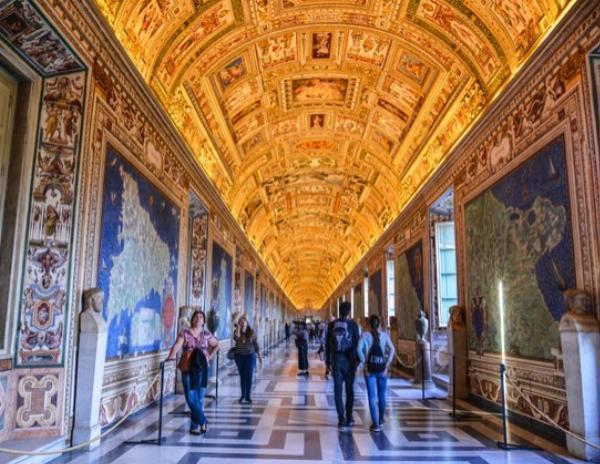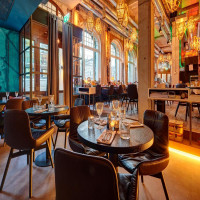Exploring the Vatican Museums & Sistine Chapel: A Journey Through Art and History

Strong 8k brings an ultra-HD IPTV experience to your living room and your pocket.
Nestled within the heart of Vatican City, the Vatican Museums and Sistine Chapel are not just places of religious significance but also treasure troves of artistic and historical wonders. These iconic landmarks draw millions of visitors each year, eager to explore their vast collections and marvel at the masterpieces housed within their walls. In this blog, we'll take an in-depth journey through the Vatican Museums and the Sistine Chapel, uncovering their rich history, artistic splendors, and practical tips for securing your Vatican Museums & Sistine Chapel tickets.
The Vatican Museums: An Overview
The Vatican Museums, established in the early 16th century by Pope Julius II, are a complex of art and Christian museums located within Vatican City. They house one of the largest and most impressive art collections in the world, amassed by the Roman Catholic Church over centuries. The museums span over 54 galleries, or "sale," and are renowned for their incredible works of art, including classical sculptures, Renaissance paintings, and intricate tapestries.
Historical Background
The origins of the Vatican Museums can be traced back to Pope Julius II, who started the collection with a single sculpture, the Laocoön and His Sons. Over the years, successive popes added to the collection, resulting in a diverse and comprehensive assembly of art that spans different periods and styles. The museums officially opened to the public in 1771, and since then, they have continued to grow, both in size and in the scope of their collections.
Key Highlights of the Vatican Museums
The Gregorian Egyptian Museum
Established by Pope Gregory XVI in 1839, this museum showcases artifacts from ancient Egypt, including mummies, sarcophagi, and statues. It provides a fascinating glimpse into the religious and cultural practices of ancient Egyptian civilization.
The Pio-Clementine Museum
Named after Popes Clement XIV and Pius VI, this museum is famous for its classical antiquities. Highlights include the Apollo Belvedere and the Belvedere Torso, both of which have significantly influenced Western art.
The Gallery of Maps
A visually stunning corridor adorned with topographical maps of Italy, painted between 1580 and 1585. The gallery's ceiling is equally impressive, with detailed frescoes depicting various religious themes.
The Raphael Rooms
These four rooms, also known as the Stanze di Raffaello, were painted by the Renaissance master Raphael and his students. They include some of Raphael's most famous works, such as The School of Athens, which depicts various classical philosophers in a grand architectural setting.
The Collection of Modern Religious Art
Featuring works by renowned artists like Vincent van Gogh, Paul Gauguin, and Salvador Dalí, this collection bridges the gap between religious themes and modern artistic expression.
The Sistine Chapel: A Masterpiece of Renaissance Art
Arguably the most famous part of the Vatican Museums is the Sistine Chapel. Commissioned by Pope Sixtus IV in 1475, the chapel is named after him and serves as the official residence of the Pope. However, its true fame comes from the extraordinary frescoes that adorn its walls and ceiling, painted by some of the greatest artists of the Renaissance.
Michelangelo’s Ceiling
The ceiling of the Sistine Chapel, painted by Michelangelo between 1508 and 1512, is considered one of the greatest artistic achievements in history. It depicts nine scenes from the Book of Genesis, including the iconic Creation of Adam, where God's hand reaches out to give life to Adam. The ceiling also features numerous prophets and sibyls, as well as an intricate array of figures and decorations that showcase Michelangelo's unparalleled skill and creativity.
The Last Judgment
In addition to the ceiling, Michelangelo also painted The Last Judgment on the altar wall of the Sistine Chapel between 1536 and 1541. This monumental fresco depicts the second coming of Christ and the final judgment of souls, with figures of the blessed ascending to heaven and the damned being cast into hell. The work is notable for its dramatic composition, emotional intensity, and intricate details.
Other Notable Artists
While Michelangelo's works are the most famous, the Sistine Chapel also features frescoes by other renowned artists, including Sandro Botticelli, Pietro Perugino, and Domenico Ghirlandaio. These frescoes, located on the chapel's side walls, depict scenes from the lives of Moses and Christ and contribute to the chapel's overall narrative and artistic coherence.
Practical Tips for Visiting the Vatican Museums & Sistine Chapel
Visiting the Vatican Museums and the Sistine Chapel is a must for anyone traveling to Rome, but it requires some planning to make the most of your experience. Here are some practical tips to help you navigate your visit:
1. Purchase Tickets in Advance
Given the immense popularity of the Vatican Museums and the Sistine Chapel, it is highly recommended to purchase your Vatican Museums & Sistine Chapel tickets in advance. This not only guarantees your entry but also allows you to skip the often long and tedious lines at the entrance. Tickets can be purchased online through the official Vatican Museums website or through various authorized ticket vendors.
2. Choose the Right Time to Visit
The Vatican Museums can get extremely crowded, especially during peak tourist seasons. To avoid the largest crowds, consider visiting early in the morning or late in the afternoon. Wednesday mornings are typically less busy, as many visitors attend the Papal Audience in St. Peter's Square.
3. Consider a Guided Tour
A guided tour can greatly enhance your experience, providing valuable insights into the history and significance of the artworks. Many tours also include skip-the-line access and can help you navigate the vast complex more efficiently. There are various options available, from group tours to private tours, depending on your preferences and budget.
4. Allow Plenty of Time
The Vatican Museums are vast, and there is so much to see that you should allow at least three to four hours for your visit. If you are an art enthusiast, you may want to allocate even more time to fully appreciate the collections.
5. Dress Appropriately
As the Vatican Museums and Sistine Chapel are places of religious significance, there is a strict dress code in place. Visitors are required to cover their shoulders and knees, so make sure to dress modestly. Avoid wearing hats inside the museums and chapel.
6. Plan Your Route
The Vatican Museums are extensive, and it can be easy to get overwhelmed. It's a good idea to plan your route in advance, focusing on the highlights that interest you the most. Maps are available at the entrance, and there are also signage and staff to help guide you.
7. Be Respectful
Remember that the Vatican Museums and the Sistine Chapel are not just tourist attractions but also places of worship and cultural heritage. Be respectful of the space and other visitors by speaking quietly, not using flash photography, and refraining from touching the artworks.
Note: IndiBlogHub features both user-submitted and editorial content. We do not verify third-party contributions. Read our Disclaimer and Privacy Policyfor details.


